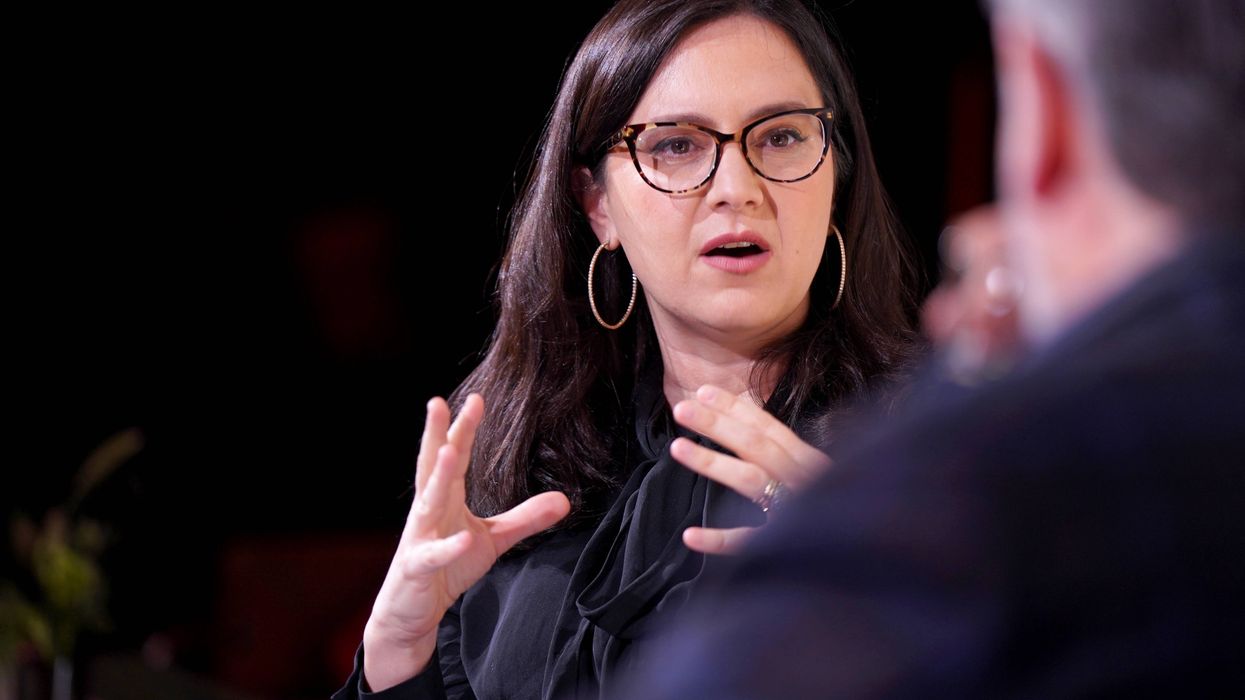April, 13 2011, 02:08pm EDT
Experts: As Traditional Banks Fail to Meet More and More Local Needs, Community Investing Poised to Break Through to Mainstream in 2011
Already One of the Fastest-Growing Aspects of Socially Responsible and Sustainable Investing, Community Investing’s Continued Rise Seen As Fueled by 3 Major Trends Among Consumers, Institutions.
WASHINGTON
"Community investing" is already the unsung hero in thousands of towns and neighborhoods across America, where it quietly has added jobs, local services and support for small businesses whe re traditional lenders have been unable or unwilling to do so. In 2011, community investing is poised to become much more widely visible as a result of three trends that could boost related investments from individuals and institutions, according to experts from the Social Investment Forum, Green America, One PacificCoast Bank and the National Federation of Community Development Credit Unions.
Community investment involves capital from investors and lenders that is directed, typically via community development financial institutions (CDFIs) and other community investing institutions, to communities and individuals that are underserved by traditional financial services. According to a major 2010 Social Investment Forum Foundation report (the most recent data set currently available), assets in community investing institutions rose more than 60 percent from $25 billion in 2007 to $41.7 billion at the start of 2010, reflecting healthy growth in all four categories of community investing institutions: community development banks, community development credit unions, community development loan funds and community development venture capital funds. * (For more information, see https://www.socialinvest.org/resources/research/documents/2010TrendsES.pdf.)
In a news conference today, experts from the Social Investment Forum, Green America, One PacificCoast Bank and the National Federation of Community Development Credit Unions identified three trends expected to continue leading to a surge in community investing assets in 2011:
- Consumers breaking up with mega-banks due to high fees and other abusive practices. Community development credit unions and banks have benefited from increased membership, assets and deposits in recent years, helped in part by consumers dissatisfied with mainstream banks that raised fees and cut back on credit as the recent US recession unfolded after December 2007. In 2010 and 2011, The Huffington Post and Green America have mounted major campaigns to encourage consumers to dump "abusive mega banks" in favor of community investing institutions. (See https://www.greenamerica.org/about/newsroom/releases/2011-02-14.cfm and https://www.adweek.com/aw/content_display/data-center/research/e3id2a9a8ed9c4a58a957d7c4820cedc7f9 for more information.)
- Rising institutional interest in community investing. The latest SIF Trends report shows that institutions in several categories are now investing more in community investing, thanks in part to SIF's education and outreach efforts around this issue to financial advisors, investment managers and religious institutions . According to new data from the Sustainable Endowments Institute, colleges and universities are now among the leaders in moving assets into community investing . Major institutions that have recently turned their attention to community investing include Mount Holyoke , Macalester College , Dickinson, Lehigh, Vanderbilt, and Skidmore .
- Growing consumer awareness of community investing success stories. Most CDFI banks were formed after 1994, initially as small institutions to serve communities that had little access to financial institutions and services. Over the past decades, these institutions have grown at a greater rate than conventional banks of the same size as they have met pent-up demand . An example of this demand: In a recent one-month period, Green America received nearly 15,000 orders and downloads for its new Guide to Community Investing, which helps individual investors take part in this fast-growing field. (See https://www.greenamerica.org/socialinvesting/communityinvesting/orderguide.cfm.) This is where success breeds more success: As community investing institutions meet local demands, they attract additional assets from individuals and institutions wanting to be part of such positive change and help local institutions to flourish.
Fran Teplitz , director of social investing & strategic outreach , Green America said: "The fact that community investing has grown steadily over the past decade, despite fears of capital constraints and the impacts of the market downturn, is a strong indicator for future growth. Add to that consumers ' continuing frustration around mega-banks, and the growing movement to support local economies, and we're likely to see continued growth of CI in 2011 and beyond."
Meg Voorhes, deputy director and research director, Social Investment Forum, said: " For many years, investment managers and advisors specializing in socially responsible investing have helped clients allocate a portion of their portfolios to community investing. It is exciting to see a new wave of interest in community investing as foundations and other institutions look for investments that will have high social impact."
Cliff Rosenthal, president and CEO, National Federation of Community Development Credit Unions, and a member of the board of directors of the Social Investment Forum, said: "Many Community Development Credit Unions and other CDFIs have played a crucial role throughout the recession in providing credit to borrowers who were shut out of the conventional capital markets."
Kat Taylor, founding director, One PacificCoast Bank, said: "We believe that Beneficial Banking -- providing fair and transparent transactional and savings services and loan capital for business and job growth in all communities -- is what all banks should deliver for the privilege of federal deposit insurance. In particular, we focus on lending that supports clean technology solutions, regenerative agriculture and natural resource use, critical community institutions, job growth and a living wage, as well as the resilience of consumers in times of setback. Banking that supports people and the planet will be critical in serving the nation as a whole as well as marginalized communities in order to move toward reliable prosperity for all. We understand that a bank cannot measure success and sustainability by focusing on profits alone, which is why community development financial institutions are so important."
BACKGROUND: THE RISE OF COMMUNITY INVESTING
According to the Social Investment Forum's 2010 data, top-level trends in community investing include the following:
- Assets in Community Development Banks grew to $17.3 billion by yearend 2009, up 34 percent from the 2006 total of $12.9 billion and sixfold from $2.9 billion in 1999.
- Assets in Community Development Credit Unions grew to $11.1 billion at the end of 2009, up 76 percent from $6.3 billion in 2006 and by more than a factor of 18 since 1999, when they stood at $610 million.
- Assets in Community Development Loan Funds grew to approximately $11.3 billion at the end of 2009, up approximately 145 percent from $4.6 billion in 2006 and more than six times from $1.7 billion in 1999. Of the 2009 total, approximately $2.2 billion are in US-based international microfinance funds that provide or guarantee loans for small-business creation and community development abroad. *
- Assets in Community Development Venture Capital Funds grew to $2 billion in 2009, an increase of 67 percent from $1.2 billion in yearend 2006 and 1200 percent from $150 million in 1999.
A major factor in CDFIs' asset growth has been the capital they have received from the US government, as well as foundations and other institutional investors. US Treasury programs stepped up assistance to CDFIs in 2009 as part of US government economic stimulus and recovery programs. In recent years, a number of campaigns, touting such concepts as "program-related investing" and "impact investing" have helped to increase awareness among foundations, other institutional investors and high-net-worth individuals of the high social impact associated with community investing strategies. However, the threat of a pullback in federal support for CDFIs has the potential to put a crimp in the rise of community investing as the very point where communities need it the most, according to the experts.
Green America is a not-for-profit membership organization founded in 1982 and known until January 1, 2009 as "Co-op America." Green America's mission is to harness economic power--the strength of consumers, investors, businesses, and the marketplace--to create a socially just and environmentally sustainable society.
LATEST NEWS
YouTube, TikTok Deleted ‘60 Minutes’ CECOT Clips Amid Paramount Takedown Push
The segment on the notorious torture prison—where the Trump administration has been unlawfully deporting Venezuelans—went viral on social media after being inadvertently aired in Canada.
Dec 23, 2025
Websites including YouTube and TikTok this week removed posts of a CBS News "60 Minutes" segment on a notorious prison in El Salvador, where Trump the administration has been illegally deporting Venezuelan immigrants, after being notified that publishing the clip violated parent company's copyright.
The segment on the Terrorism Confinement Center (CECOT)—which was intended to air on Sunday's episode of "60 Minutes"—was pulled by right-wing CBS News editor-in-chief Bari Weiss, who claimed that the story "was not ready" for broadcast, despite thorough editing and clearance by key company officials.
“Our story was screened five times and cleared by both CBS attorneys and Standards and Practices," said "60 Minutes" correspondent Sharyn Alfonsi, who reported the segment. “It is factually correct. In my view, pulling it now, after every rigorous internal check has been met, is not an editorial decision, it is a political one.”
The segment—which can still be viewed on sites including X—was shared by social media users after a Canadian network received and broadcast an original version of the "60 Minutes" episode containing the CECOT piece prior to CBS pulling the story. The social media posts containing the segment were reportedly removed after CBS parent company Paramount Skydance filed copyright claims.
A CBS News representative said that “Paramount’s content protection team is in the process of routine take down orders for the unaired and unauthorized segment.”
Weiss—who also founded and still edits the Paramount Skydance-owned Free Press—has faced criticism for other moves, including presiding over the removal of parts of a previous "60 Minutes" interview with President Donald Trump regarding potential corruption stemming from his family’s massive cryptocurrency profits.
On Tuesday, Axios reported that Weiss is planning a broad overhaul of standards and procedures at the network, where she was hired by Paramount Skydance CEO and Trump supporter David Ellison in October, despite a lack of broadcasting experience.
Keep ReadingShow Less
Israeli Defense Minister Tries to Walk Back Vow to 'Never Leave Gaza,' Build Settlements
The remarks drew critical responses, including from other Israelis and the White House.
Dec 23, 2025
Israeli Defense Minister Israel Katz "said the silent part out loud" on Tuesday, then promptly tried to walk back his comments that his country would not only never leave the Gaza Strip, but also reestablish settlements in the decimated exclave.
Israel evacuated Jewish settlements in Gaza two decades ago, but some officials have pushed for ethnically cleansing the strip of Palestinians and recolonizing it, particularly since the Hamas-led October 7, 2023 attack and the devastating Israeli assault that followed.
The Times of Israel on Tuesday translated Katz's remarks—made during an event about expanding Beit El, a Jewish settlement in the illegally occupied West Bank—from Hebrew to English:
"With God's help, when the time comes, also in northern Gaza, we will establish Nahal pioneer groups in place of the settlements that were evacuated," he said. "We'll do it in the right way, at the appropriate time."
Katz was referring to the Nahal military unit that, in part, lets youths combine pioneering activities with military service. In the past, many of the outposts established by the unit went on to evolve into full-fledged settlements.
"We are deep inside Gaza, and we will never leave Gaza—there will be no such thing," Katz said. "We are here to defend and to prevent what happened from happening again."
The so-called peace plan for Gaza that US President Donald Trump and Israeli Prime Minister Benjamin Netanyahu announced at the White House in late September notably states that "Israel will not occupy or annex Gaza," and "the Israel Defense Forces (IDF) will withdraw based on standards, milestones, and timeframes linked to demilitarization."
Gadi Eisenkot, a former IDF chief of staff who launched a new political party a few months ago, responded to Katz on social media, writing in Hebrew, "While the government votes with one hand in favor of the Trump plan, it sells myths with the other hand about isolated settlement nuclei in the strip."
"Instead of strengthening security and bringing about an enlistment law that will bolster the IDF, the government, driven by narrow political considerations, continues to scatter irresponsible and empty declarations that only harm Israel's standing in the world," he added.
The White House was also critical of Katz's comments, with an unnamed official saying that "the more Israel provokes, the less the Arab countries want to work with them."
"The United States remains fully committed to President Trump's 20-point peace plan, which was agreed to by all parties and endorsed by the international community," the official continued. "The plan envisions a phased approach to security, governance, and reconstruction in Gaza. We expect all parties to adhere to the commitments they made under the 20-point plan."
Later Tuesday, Katz's office said that "the minister of defense's remarks regarding the integration of Nahal units in the northern Gaza Strip were made solely in a security context. The government has no intention of establishing settlements in the Gaza Strip. The minister of defense emphasized the central principle of border defense in every arena: The IDF is the first and last line of defense for Israel's citizens, and the state of Israel relies for its protection solely on it and on the security forces."
Katz became defense minister in November 2024, just weeks before the International Criminal Court issued arrest warrants for his fired predecessor, Yoav Gallat, and Netanyahu over Israel's assault on and blockade of Gaza. When Katz took on the new role after serving as foreign minister, Palestine defenders accused the prime minister of swapping one "genocidal lunatic" for another.
Israel faces an ongoing genocide case at the International Court of Justice for its mass slaughter of Palestinians in Gaza. As of Tuesday, local officials put the death toll since October 2023 at 70,942, with another 171,195 Palestinians wounded, though global experts warn the true tallies are likely far higher.
At least 406 of those confirmed deaths have occurred since Israel and Hamas agreed to a ceasefire that took effect October 10. In a Monday letter demanding action from the White House, dozens of Democratic US lawmakers noted Israel's "continued bombardment against civilians, destruction of property, and insufficient delivery of humanitarian aid."
Keep ReadingShow Less
Sanders Slams Private Equity Scrooges Ending Paid Holidays for Walgreens Workers
"While the rich get richer, workers are struggling, and your decision to cut workers' paid vacation is making the problem worse."
Dec 23, 2025
Independent US Sen. Bernie Sanders on Tuesday urged the private equity firm that recently acquired Walgreens to reverse its decision to strip hourly workers at the second-largest US pharmacy chain of paid days off on Christmas and other major holidays.
After Sycamore Partners finalized its $10 billion purchase of Walgreens in late August, the pharmacy chain—now headed by CEO Mike Motz—eliminated paid holidays for New Year's Day, Memorial Day, Independence Day, Labor Day, Thanksgiving, and Christmas. Workers were notified of the move, which was first reported by Bloomberg, in October.
The move is typical of what private equity firms—sometimes called vulture capitalists—often do in order to maximize profits. In addition to slashing paid time off and benefits, they often reduce or freeze pay, fire workers, close locations, introduce aggressive sales targets, and reduce job security by replacing full-time positions with hourly or independently contracted workers. Walgreens announced last year that it planned on closing around 1,200 of its roughly 8,000 US stores, citing their struggling performance.
"This Thanksgiving, Walgreens' hourly workers faced the impossible choice between losing pay and spending the holiday with their loved ones," Sanders (Vt.)—who is the ranking member of the Senate Health, Education, Labor, and Pensions (HELP) Committee—wrote Tuesday in a letter to Sycamore Partners founder and managing director Stefan Kaluzny.
"Walgreens employs 220,000 employees, the vast majority of whom are hourly workers... Sycamore Partners' decision to cut paid holidays for these hourly workers is unfortunately not surprising," the senator continued. "The firm follows the private equity playbook of buying businesses and aggressively extracting profit while using and abusing workers."
"For example, just one year after Sycamore Partners purchased Staples, the firm extracted $1 billion from the company as it closed 100 stores and laid off 7,000 workers," Sanders noted. "That same year, Sycamore Partners drove Nine West into bankruptcy and was accused of siphoning off over $1 billion in funds."
"Meanwhile, from 2016-22, companies owned by Sycamore Partners racked up over $3 million in labor violations, including wage-and-hour and workplace safety and health violations," he added.
During the holiday season, we all want to spend time with our loved ones. And yet, just two months after buying Walgreens for $10 billion, the private equity firm Sycamore Partners stripped hourly workers of paid vacation, including Christmas and New Year’s Day. Shameful.
[image or embed]
— Senator Bernie Sanders (@sanders.senate.gov) December 23, 2025 at 9:41 AM
Sanders contrasted a reality in which "60% of Americans are living paycheck to paycheck" with the fact that "more private equity managers make over $100 million annually than investment bankers, top financial executives, and professional athletes combined."
"While the rich get richer, workers are struggling, and your decision to cut workers' paid vacation leave is making the problem worse," he stressed. "Some Walgreens workers make as little as $15 an hour. Cutting their paid leave will make it even more difficult for these workers to pay for housing, childcare, healthcare, and groceries."
"In short," Sanders concluded, "Sycamore Partners is forcing workers to sacrifice their basic needs for private equity profit."
Keep ReadingShow Less
Most Popular


